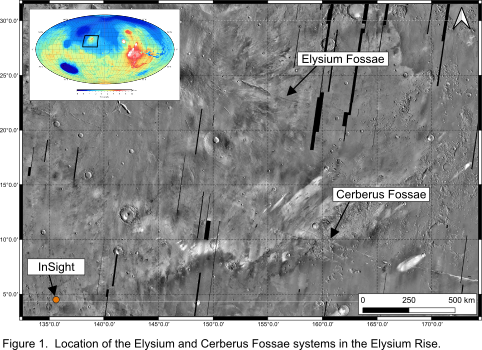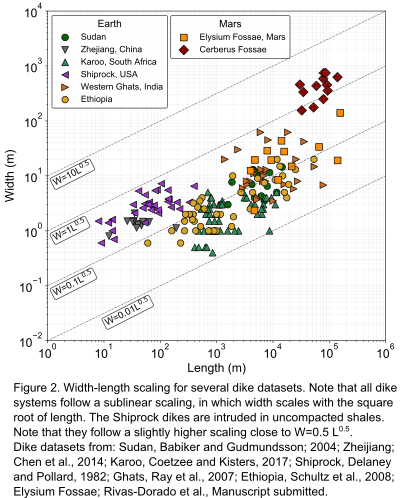- Universidad Complutense de Madrid, Facultad de Ciencias Geologicas, Geodinamica, Estratigrafia y Paleontologia, Madrid, Spain (samuelrivas@ucm.es)
1. Introduction
The Cerberus Fossae graben system (Figure 1) has recently received significant attention in the planetary science community due to the recent findings by InSight [1]. Specifically, the Cerberus Fossae fault system has been suggested as the possible source of shallow crustal seismic activity. On the other hand, the structures observed at Cerberus have long been suggested as being dike-induced grabens [2]. We recently applied area-balancing to a set of long linear graben in Elysium Fossae to infer dike subsurface geometries and emplacement conditions [3]. In this work, we apply the same methodology at Cerberus Fossae to assess the possibility that these structures are the result of dike intrusions, and to make inferences about the crustal properties at a local scale.

2. Cross-section balancing and geometry of the intrusions
The studied grabens are between 30-140 km long, and between 0.6-2.5 km wide, being therefore similar in length to the structures at Elysium Fossae, but significantly wider. 12 orthogonal cross sections to the grabens were constructed across the same number of structures. Topographic profiles were constructed using the PEDR dataset of the MOLA instrument.
Section balancing is achieved by calculating the lost area within the graben and estimating the heave of the graben-bounding faults. Graben area is calculated under basic assumptions; that the faults have angles of 60º, that the maximum depth observed in the graben is the actual depth, and that the undisturbed topography away from the faults represents the regional elevation. This allows to obtain a proxy of the depth of the upper dike tip and of dike width, which is assumed as equivalent to the sum of fault heaves.
Applying this methodology to the Cerberus grabens yields results which are consistent with previous work in Elysium, with theoretical considerations of dike-induced grabens, and with numerical experiments. However, the estimated dike widths at Cerberus are between 100-800 m, much larger than in any other Martian or terrestrial example. Despite this greater dimensions, width-length scaling relationships for the inferred Cerberus dikes are observed to be broadly consistent with sublinear scaling (Figure 2), which is characteristic of fluid-induced cracks [4]. Therefore, their geometry is consistent with that of giant dikes.

The much larger widths of the Cerberus dikes are an interesting feature. Martian dikes are expected to be of greater size relative to terrestrial dikes [5]. However, the Cerberus dikes are roughly one order of magnitude above the average width of the Elysium dikes. An observation made in several terrestrial datasets is that dikes intruded in uncompacted or fractured rocks tend to have greater widths than those intruded in intact rock [6]. We used simple principles of Linear Elastic Fracture Mechanics (LEFM), to explore the possibility that the Cerberus dike hint to a, at least locally, fractured crust.
3. Stress factors and their implications for the state of the crust
The stress intensity (Ki) factor is a measure of the stress required at the tip of a geological discontinuity to induce deformation. In the case of mode-I discontinuities (dikes, veins, and joints), the corresponding stress intensity factor is KI, and must be above a critical value (KIc) for propagation to occur. The fundamental expression of KI is [7]:
(1) KI=Yσe√(πa)
where Y is a geometric parameter dependant on fracture geometry, σe is excess pressure, and a is the fracture’s half length. However, if the opening of an individual fracture and the mechanical properties of the host rock are known, KI can also be calculated with the compact formula [8]:
(2) KI= [E/4(1-ν2)] Dmax √(π/a)
Where E is Young’s Modulus, υ is Poisson’s ratio, and Dmax is maximum opening. (1) shows clearly that KI depends mainly on fracture geometry and driving pressure. Therefore, cracks with similar geometry and formed under similar conditions should have similar values of KI. Previously calculated KI values at Elysium Fossae, which assumed intact basalts as the host rock, are between 3-15 GPa m1/2. These yielded reasonable estimations of excess pressures, in line with overpressures in Martian magmatic chambers. Since both Elysium and Cerberus Fossae belong to the same volcanic system, the dikes at Cerberus would be expected to reflect similar ranges of stress factors and excess pressures. However, similar KI values can only be obtained here if the properties of a fractured rock mass are presumed. Under this assumption, the inferred Cerberus dikes yield stress factors, calculated with (2), which are consistent with the theoretical factors of elliptical cracks formed at excess pressures of around 25 MPa (Figure 3).
4. Conclusions
Cross-section balancing applied in the Cerberus Fossae grabens yields values that describe an underlying dike system consistent with previous work and with the expected geometry of fluid-induced cracks. Furthermore, for these dikes to be emplaced under similar conditions to the neighbouring dike systems of Elysium Fossae, the host rock at Cerberus needs to have properties akin to those of a weak rock mass. This would provide an explanation for the gigantic dimensions of the dikes, and would likely have implications for the behaviour of the possibly seismogenic faults at depth.
References
[1] Giardini, D., et al., 2020. The Seismicity of Mars. Nat. Geosci. 13, 205–212. https://doi.org/10.1038/s41561-020-0539-8.
[2] Plescia, J.B., 2003. Cerberus Fossae, Elysium, Mars: A source for lava and water. Icarus 164, 79–95. https://doi.org/10.1016/S0019-1035(03)00139-8.
[3] Rivas-Dorado, S., et al. Submitted manuscript.
[4] Olson, J.E.: Sublinear scaling of fracture aperture versus length: An exception or the rule?, Journal of Geophysical Research, Vol. 108, NO.108, 2003.
[5] Wilson, L., Parfitt, E., 1990. Widths of dikes on Earth and Mars, LPI Technical Report 90-06. Houston.
[6] Delaney, P.T., Pollard, D.D., 1981. Deformation of Host Rocks and Flow of Magma during Growth of Minette Dikes and Breccia-bearing Intrusions near Ship Rock, New Mexico. USGS Prof. Pap. 1202 69.
[7] Lawn, B.R., Wilshaw, T.R.: Fracture of Brittle Solids, 204 pp., Cambridge Univ. Press, 1975.
[8] Schultz, R.A., 2019. Geologic Fracture Mechanics. Cambridge University Press, Cambridge. https://doi.org/https://doi.org/10.1017/9781316996737.
How to cite: Rivas-Dorado, S., Ruiz, J., and Romeo, I.: Evidence of dikes intruding a fractured crust beneath Cerberus Fossae, Europlanet Science Congress 2020, online, 21 Sep–9 Oct 2020, EPSC2020-642, https://doi.org/10.5194/epsc2020-642, 2020.

